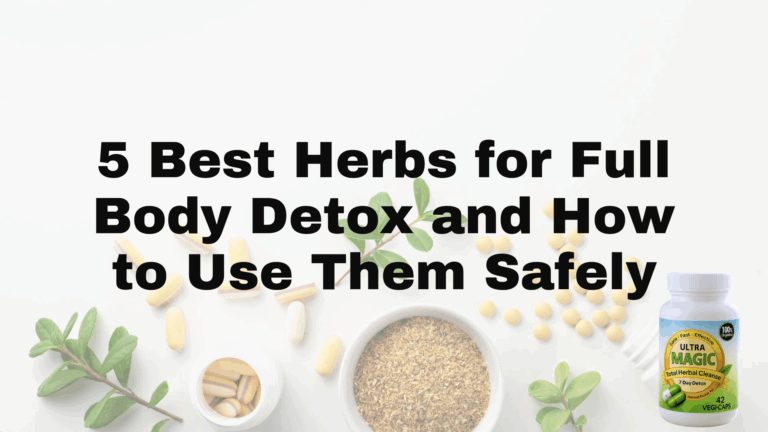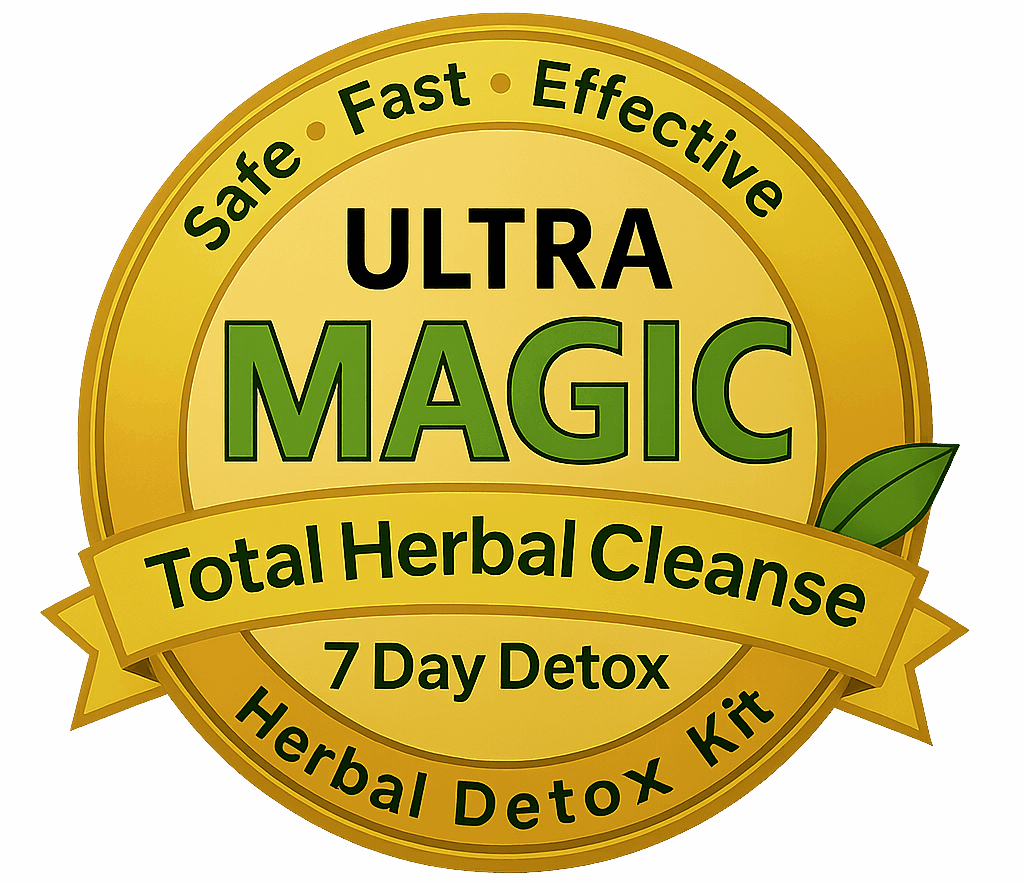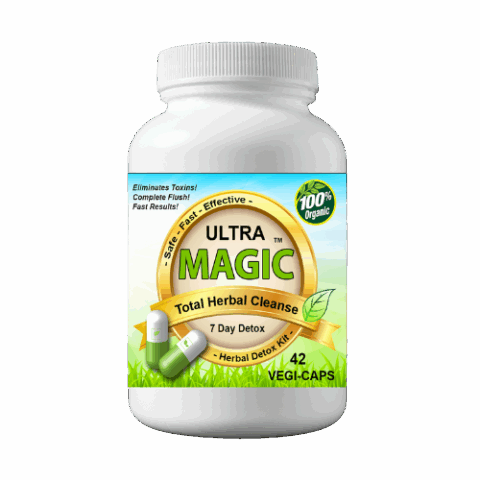
5 Best Herbs for Full Body Detox and How to Use Them Safely
You want a real, full‑body reset—not another “quick fix” that leaves you dehydrated and disappointed. Your body already runs powerful detox systems through the liver, kidneys, lymph, gut, and skin, but stress, poor sleep, ultra‑processed foods, and environmental exposures can strain those pathways. The challenge is cutting through the hype to find herbs that actually support these organs, knowing how to use them correctly, and avoiding combinations that clash with your meds or goals—especially if you’re on a tight timeline.
This guide spotlights five herbs with meaningful traditional use and modern support for whole‑system detox: a comprehensive 7‑herb blend, plus milk thistle, dandelion, burdock, and nettle. For each, you’ll learn what it is, how it supports key organs, the evidence behind it, best forms and dosing, ideal timing, and important cautions and interactions. You’ll also get practical tips to build a simple, safe protocol you can follow with confidence. First up, a targeted 7‑herb option for those who need maximum, head‑to‑toe support.
1. Magic Detox Ultra Magic Detox (7-herb blend)
If you need head‑to‑toe support on a tight timeline, Ultra Magic Detox is a focused solution. It’s a maximum‑strength, 7‑day program designed to flush toxins from urine, blood, saliva, liver, kidneys, and the digestive tract. The formula uses 100% natural, non‑GMO herbs, is lab‑tested, made in a GMP‑certified, FDA‑registered facility in Florida, ships discreetly, and is backed by a 30‑day refund.
What it is
A capsule‑based, 7‑herb blend: Burdock Root, Dandelion Root, Rhubarb Root, Goldenseal, Sheep Sorrel Herb, Cat’s Claw Bark, and Pau D’arco Bark. It’s built for “heavy users” seeking a strong yet gentle full‑body cleanse.
How it supports full-body detox
The blend targets multiple routes of elimination. Bitter roots and tonics help get digestive juices and bile moving, while kidney‑supportive herbs encourage fluid balance and waste removal—key mechanics in herbs for full body detox.
Evidence and traditional use
Modern herbalists and wellness sources recognize dandelion for gently stimulating liver function and bile flow, and burdock for supporting kidneys and clear skin—both core pathways in natural detox. Multi‑herb protocols are traditionally favored to support several organs at once rather than relying on harsh purges.
Safe use: forms, dose, timing
Use as directed on the label for the 7‑day course. For best results:
- Hydrate consistently throughout the day.
- Eat whole, minimally processed foods; limit alcohol.
- Take capsules at consistent times (often with meals) and do not skip days.
Cautions and interactions
Herbs can interact with medications and may have diuretic or digestive effects. If you’re pregnant, nursing, have a medical condition, or take prescriptions, consult a healthcare professional first. Discontinue if you notice concerning reactions and seek medical advice. Supplements support—but do not replace—healthy habits and medical care.
2. Milk thistle (liver and antioxidant support)
When people think liver support, they think milk thistle. As one of the top herbs for full body detox, it focuses on the liver’s filter role while providing antioxidant backup—useful when you want dependable, organ‑smart cleansing without harsh purges.
What it is
A classic liver herb whose active complex, silymarin, is concentrated in the seed. It’s widely recommended to support liver function during periods of increased toxin load.
How it supports full-body detox
Silymarin helps stabilize cellular membranes and stimulate detoxification pathways in liver cells while offering anti‑inflammatory, antioxidative activity. More efficient liver processing lightens the burden on kidneys, blood, and skin—key for whole‑system cleansing.
Evidence and traditional use
Wellness authorities cite milk thistle as the herb most commonly recommended for liver support. Research on silymarin shows membrane‑stabilizing and detox‑pathway support, and some studies suggest potential for aiding liver tissue regeneration.
Safe use: forms, dose, timing
Because silymarin is not very water‑soluble or well absorbed, standardized extracts are preferred over teas if your goal is targeted liver support. Teas exist, but deliver less silymarin.
- Form: Choose a standardized preparation containing 70–80% silymarin.
- Use: Follow product directions consistently; steady daily intake matters.
- Pair: Emphasize whole foods and hydration to reduce incoming toxic load.
Cautions and interactions
Herbs can trigger side effects and interact with medications—consult a health professional before starting. Nutritional supplements aren’t regulated by the FDA; source, strength, and purity can vary widely, so select reputable, quality‑tested products.
3. Dandelion root and leaf (liver, gallbladder, and diuretic support)
Dandelion is the workhorse you actually feel—gentle yet thorough. As one of the most versatile herbs for full body detox, the root and leaf team up to nudge bile flow, support the liver and gallbladder, and encourage healthy fluid balance so wastes move out, not around.
What it is
A widely used bitter herb; the entire plant is edible. Roots are commonly prepared as tea or capsules, while leaves show up in teas or salads. The root tends to deliver stronger diuretic action than other parts of the plant.
How it supports full-body detox
Bitter compounds in dandelion stimulate taste receptors, which kick off a cascade—from saliva to bile—that gets digestion moving. This supports fat breakdown and waste elimination. As a traditional diuretic, dandelion also helps the kidneys flush excess fluid and metabolites.
Evidence and traditional use
Modern wellness sources highlight dandelion for gently stimulating liver function and bile flow and note preliminary research around liver and gallbladder support. Herbalists value it as a daily tonic that pairs digestive activation with clear‑skin, kidney, and metabolic benefits.
Safe use: forms, dose, timing
Use simple, consistent routines that respect its bitter nature and mild diuretic effect.
- Tea (root or leaf): 1 heaping teaspoon per 8–10 oz boiling water; steep 5–10 minutes, covered.
- Capsules/tinctures: Follow label directions; take with water.
- Timing: Take earlier in the day if the diuretic effect disrupts sleep.
- Diet: Favor whole foods and hydrate well to assist bile flow.
Cautions and interactions
Expect increased urination. Herbs can interact with medications and trigger side effects; consult a healthcare professional before use, especially if you have medical conditions or take prescriptions. Discontinue and seek advice if adverse reactions occur.
4. Burdock root (kidneys, lymph, and skin support)
Burdock is the steady, go‑anywhere detox root. Bitter and grounding, it’s prized in Western herbalism as an “alterative”—a tonic that supports the body’s channels of elimination—making it a smart pick when you want kidney, skin, and whole‑system cleanup from herbs for full body detox.
What it is
A classic bitter root used by herbalists to encourage gentle, sustained cleansing. It’s typically taken as tea, tincture, or capsules and is well known for its earthy, slightly sweet‑bitter taste.
How it supports full-body detox
As an alterative, burdock supports the movement of wastes through the body’s elimination routes. It’s used to encourage healthy kidney function and fluid balance, while its prebiotic inulin and other starches support nutrient assimilation—useful when you’re rebuilding after a cleanse. Skin benefits often follow as waste moves out efficiently.
Evidence and traditional use
Modern wellness sources highlight burdock’s long use for kidney support and clear, healthy skin, noting its alterative action that “supports channels of elimination.” It’s also noted as rich in inulin and prebiotic starches, aligning with its traditional role as a nourishing, steady detox ally.
Safe use: forms, dose, timing
Start simple and be consistent; burdock works best over days to weeks.
- Tea (root): 1 heaping tsp per 8–10 oz boiling water; steep 5–10 minutes, covered.
- Capsules/tincture: Use per label directions with water.
- Timing: Take earlier in the day to avoid sleep‑disrupting urination.
- Hydration: Drink water regularly to support kidney clearance.
Cautions and interactions
Expect a mild diuretic effect. Herbs can interact with medications and may trigger side effects; consult a healthcare professional before use, especially if pregnant, nursing, managing a condition, or on prescriptions. Stop use and seek advice if adverse reactions occur.
5. Nettle leaf (kidney and whole-body tonic)
When your system feels “stuck,” nettle is a steady reset. This mineral‑rich tonic supports kidney elimination while backing up the liver, skin, and joints—making it a reliable addition to herbs for full body detox, especially during seasonal cleanses.
What it is
Nettle (Urtica dioica) leaf has a mild, grassy taste and is used as a tea or cooked green. Even dried leaf can retain tiny stinging hairs, so handle and strain well when preparing.
How it supports full-body detox
Nettle helps the kidneys eliminate waste and supports detox processes in the liver, promoting efficient fluid movement and clearance. As a classic spring tonic, it’s also chosen for skin and joint support when the body feels stagnated.
Evidence and traditional use
Modern herbal sources call nettle the “mother of all spring tonics,” traditionally used for skin support and whole‑body nourishment. It’s noted for aiding kidney waste removal and liver detox functions, and it naturally provides iron and vitamin C.
Safe use: forms, dose, timing
Keep it simple and consistent; pair with hydration and whole foods.
- Tea (leaf): 1 heaping tsp per 8–10 oz boiling water; steep 5–10 minutes, covered.
- Capsules/tincture: Use as directed on the product label.
- Food use: Steam and add to soups or salads for a gentle daily tonic.
- Timing: Take earlier in the day if increased urination affects sleep.
Cautions and interactions
Expect a mild diuretic effect. Handle dried leaf carefully to avoid irritation from hairs, and strain tea well. Herbs may interact with medications; consult a healthcare professional if pregnant, nursing, managing a condition, or on prescriptions. Stop use if adverse reactions occur.
Key takeaways
Smart detoxing isn’t about purges—it’s about supporting the organs that already do the job. A simple, consistent plan using targeted herbs, steady hydration, and whole foods can meaningfully help the liver, kidneys, lymph, gut, and skin work more efficiently, especially when you’re under time pressure or coming off a heavier load.
- Match herbs to organs: Milk thistle for liver resilience; dandelion for bile flow and gentle diuresis; burdock for kidneys, lymph, and skin; nettle as a mineral‑rich kidney tonic.
- Use the right forms: Prefer standardized milk thistle (70–80% silymarin); prepare roots/leaves as teas or use capsules/tinctures as directed.
- Respect timing: Dose consistently; take diuretics earlier in the day.
- Fuel the process: Hydrate and favor minimally processed foods.
- Stay safe: Screen for med interactions, pregnancy, or conditions.
Need an organ‑smart, weeklong option? Explore the 7‑herb Ultra Magic Detox at Magic Detox.



